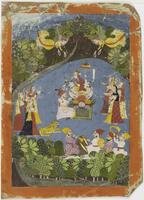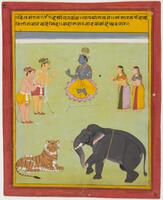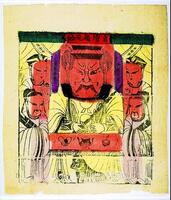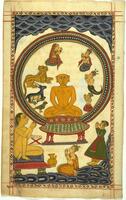9 Items in this Learning Collection
Collection Object
Collection Object
Collection Object
Collection Object
Collection Object
Collection Object
Copyright
All Rights Reserved
()
Digambara Jain manuscript page: Jina and monk with Lakshmi-Narayana & Ardhanarishvara (fol. No. 42)
Accession Number
1975/2.166
Title
Digambara Jain manuscript page: Jina and monk with Lakshmi-Narayana & Ardhanarishvara (fol. No. 42)
Artist(s)
Artist Unknown, India, Rajasthan, Sirohi School
Object Creation Date
18th century
Medium & Support
ink, opaque watercolor, and gold on paper
Dimensions
11 3/8 in x 7 1/8 in (28.89 cm x 18.1 cm)
Credit Line
Gift of Dr. and Mrs. Leo S. Figiel and Dr. and Mrs. Steven J. Figiel
Label copy
Both the golden-hued jina seated on a simple throne at the upper right and the monk who venerates him are naked, identifying them as Digambara (sky-clad) jina. Seated below them, suggesting a subservient position, are the major Hindu gods: on the left sits the blue-skinned Vishnu (also known as Narayana) with his consort Lakshmi; on the right appears Shiva in his form as Ardhanarishvara, “the god whose half is woman.” Over them all, a human-faced sun shines from a cloud-streaked sky.
The dedication of sacred manuscript books for shrines is required of Jain devotees, and book production reflects the integral relationship among the laity, monastic community, and the Jina. Commissioning a book fulfills the lay obligation of charity, while beholding a book helps the individual achieve the proper mental state for spiritual guidance. It was customary for a lay donor to commission a copy of a text for presentation to his spiritual teacher and ultimately to the monk’s temple library. Over the centuries, libraries received great quantities of texts, which were employed in the instruction of monks and nuns. Monks and nuns were discouraged, however, from practicing the art of painting: one text expressly warns them of the power of painting to arouse sensual feelings.
Fall 2010 Gallery Rotation - Natsu Oyobe, April 2010
Illustrated Digambara manuscripts are less well known to Western collectors than those of the Shvetambara sect, but the Museum is fortunate to own eighteen pages of this delightful series. Both the golden-hued jina seated on a simple throne at the upper right and the monk who venerates him are naked, identifying them as Digambara (sky-clad). Seated below them, suggesting a subservient position, are the major Hindu gods: on the left sits the blue-skinned Vishnu (also known as Narayana) with his consort Lakshmi; on the right appears Shiva in his form as Ardhanarishvara, “the god whose half is woman.” Over them all, a human-faced sun shines from a cloud-streaked sky.
Exhibited in "Divine Encounters, Earthly Pleasures: Twenty Centuries of Indian Art," 12/12/03-2/22/04.
Gallery Rotation Fall 2010
Jina and monk with Lakshmi, Narayana, and Ardhanarishvara from a Digambara Jain manuscript
India, Rajasthan, Sirohi
18th century
Ink, opaque watercolor, and gold on paper
Gift of Dr. and Mrs. Leo S. Figiel and Dr. and Mrs. Steven J. Figiel, 1975/2.166
Both the golden-hued Jina seated on a simple throne at the upper right and the monk who venerates him are naked, identifying them as Digambara (sky-clad) jina. Seated below them, suggesting a subservient position, are the major Hindu gods: on the left sits the blue-skinned Vishnu (also known as Narayana) with his consort Lakshmi; on the right appears Shiva in his form as Ardhanarishvara, “the god whose half is woman.” Over them all, a human-faced sun shines from a cloud-streaked sky.
The dedication of sacred manuscript books for shrines is required of Jain devotees, and book production reflects the integral relationship among the laity, monastic community, and the Jina. Commissioning a book fulfills the lay obligation of charity, while beholding a book helps the individual achieve the proper mental state for spiritual guidance. It was customary for a lay donor to commission a copy of a text for presentation to his spiritual teacher and ultimately to the monk’s temple library. Over the centuries, libraries received great quantities of texts, which were employed in the instruction of monks and nuns. Monks and nuns were discouraged, however, from practicing the art of painting: one text expressly warns them of the power of painting to arouse sensual feelings.
Subject matter
The dedication of sacred manuscript books for shrines is required of Jain devotees, and book production reflects the integral relationship among the laity, monastic community, and the Jina. Commissioning a book fulfills the lay obligation of charity, while beholding a book helps the individual achieve the proper mental state for spiritual guidance.
In this example, both the golden-hued jina seated on a simple throne at the upper right and the monk who venerates him are naked, identifying them as Digambara (sky-clad) jina. Seated below them, suggesting a subservient position, are the major Hindu gods: on the left sits the blue-skinned Vishnu (also known as Narayana) with his consort Lakshmi; on the right appears Shiva in his form as Ardhanarishvara, “the god whose half is woman.” Over them all, a human-faced sun shines from a cloud-streaked sky.
Physical Description
This work is painted in tones of red, green, dark blue, and orange/gold, against a light background. At the top is a sun with a many rays and a human face. Below this are two seated figures who are unclothed. They are seated on thrones decorated with colorful designs. One has reddish skin and is shown in profile, looking at the sun with hands raised. The other has orange skin and is seated in a lotus posiiton, facing front. Below them is a scene that shows two figures, a woman and a blue-skinned man, turned toward a half-man, half-woman figure who is seated on a tiger rug. These figures are dressed in colorful clothing and adorned with jewelry and hold various objects in their hands.
Primary Object Classification
Painting
Additional Object Classification(s)
Unbound Work
Collection Area
Asian
Rights
If you are interested in using an image for a publication, please visit http://umma.umich.edu/request-image for more information and to fill out the online Image Rights and Reproductions Request Form.
Keywords
Figures
Shiva
Sivaism
Vishnu
figures (representations)
flowers
flowers (plant components)
nudes
nudes (representations)
seated
sitting
suns
suns (stars)
1975/2.166
Title
Digambara Jain manuscript page: Jina and monk with Lakshmi-Narayana & Ardhanarishvara (fol. No. 42)
Artist(s)
Artist Unknown, India, Rajasthan, Sirohi School
Object Creation Date
18th century
Medium & Support
ink, opaque watercolor, and gold on paper
Dimensions
11 3/8 in x 7 1/8 in (28.89 cm x 18.1 cm)
Credit Line
Gift of Dr. and Mrs. Leo S. Figiel and Dr. and Mrs. Steven J. Figiel
Label copy
Both the golden-hued jina seated on a simple throne at the upper right and the monk who venerates him are naked, identifying them as Digambara (sky-clad) jina. Seated below them, suggesting a subservient position, are the major Hindu gods: on the left sits the blue-skinned Vishnu (also known as Narayana) with his consort Lakshmi; on the right appears Shiva in his form as Ardhanarishvara, “the god whose half is woman.” Over them all, a human-faced sun shines from a cloud-streaked sky.
The dedication of sacred manuscript books for shrines is required of Jain devotees, and book production reflects the integral relationship among the laity, monastic community, and the Jina. Commissioning a book fulfills the lay obligation of charity, while beholding a book helps the individual achieve the proper mental state for spiritual guidance. It was customary for a lay donor to commission a copy of a text for presentation to his spiritual teacher and ultimately to the monk’s temple library. Over the centuries, libraries received great quantities of texts, which were employed in the instruction of monks and nuns. Monks and nuns were discouraged, however, from practicing the art of painting: one text expressly warns them of the power of painting to arouse sensual feelings.
Fall 2010 Gallery Rotation - Natsu Oyobe, April 2010
Illustrated Digambara manuscripts are less well known to Western collectors than those of the Shvetambara sect, but the Museum is fortunate to own eighteen pages of this delightful series. Both the golden-hued jina seated on a simple throne at the upper right and the monk who venerates him are naked, identifying them as Digambara (sky-clad). Seated below them, suggesting a subservient position, are the major Hindu gods: on the left sits the blue-skinned Vishnu (also known as Narayana) with his consort Lakshmi; on the right appears Shiva in his form as Ardhanarishvara, “the god whose half is woman.” Over them all, a human-faced sun shines from a cloud-streaked sky.
Exhibited in "Divine Encounters, Earthly Pleasures: Twenty Centuries of Indian Art," 12/12/03-2/22/04.
Gallery Rotation Fall 2010
Jina and monk with Lakshmi, Narayana, and Ardhanarishvara from a Digambara Jain manuscript
India, Rajasthan, Sirohi
18th century
Ink, opaque watercolor, and gold on paper
Gift of Dr. and Mrs. Leo S. Figiel and Dr. and Mrs. Steven J. Figiel, 1975/2.166
Both the golden-hued Jina seated on a simple throne at the upper right and the monk who venerates him are naked, identifying them as Digambara (sky-clad) jina. Seated below them, suggesting a subservient position, are the major Hindu gods: on the left sits the blue-skinned Vishnu (also known as Narayana) with his consort Lakshmi; on the right appears Shiva in his form as Ardhanarishvara, “the god whose half is woman.” Over them all, a human-faced sun shines from a cloud-streaked sky.
The dedication of sacred manuscript books for shrines is required of Jain devotees, and book production reflects the integral relationship among the laity, monastic community, and the Jina. Commissioning a book fulfills the lay obligation of charity, while beholding a book helps the individual achieve the proper mental state for spiritual guidance. It was customary for a lay donor to commission a copy of a text for presentation to his spiritual teacher and ultimately to the monk’s temple library. Over the centuries, libraries received great quantities of texts, which were employed in the instruction of monks and nuns. Monks and nuns were discouraged, however, from practicing the art of painting: one text expressly warns them of the power of painting to arouse sensual feelings.
Subject matter
The dedication of sacred manuscript books for shrines is required of Jain devotees, and book production reflects the integral relationship among the laity, monastic community, and the Jina. Commissioning a book fulfills the lay obligation of charity, while beholding a book helps the individual achieve the proper mental state for spiritual guidance.
In this example, both the golden-hued jina seated on a simple throne at the upper right and the monk who venerates him are naked, identifying them as Digambara (sky-clad) jina. Seated below them, suggesting a subservient position, are the major Hindu gods: on the left sits the blue-skinned Vishnu (also known as Narayana) with his consort Lakshmi; on the right appears Shiva in his form as Ardhanarishvara, “the god whose half is woman.” Over them all, a human-faced sun shines from a cloud-streaked sky.
Physical Description
This work is painted in tones of red, green, dark blue, and orange/gold, against a light background. At the top is a sun with a many rays and a human face. Below this are two seated figures who are unclothed. They are seated on thrones decorated with colorful designs. One has reddish skin and is shown in profile, looking at the sun with hands raised. The other has orange skin and is seated in a lotus posiiton, facing front. Below them is a scene that shows two figures, a woman and a blue-skinned man, turned toward a half-man, half-woman figure who is seated on a tiger rug. These figures are dressed in colorful clothing and adorned with jewelry and hold various objects in their hands.
Primary Object Classification
Painting
Additional Object Classification(s)
Unbound Work
Collection Area
Asian
Rights
If you are interested in using an image for a publication, please visit http://umma.umich.edu/request-image for more information and to fill out the online Image Rights and Reproductions Request Form.
Keywords
Figures
Shiva
Sivaism
Vishnu
figures (representations)
flowers
flowers (plant components)
nudes
nudes (representations)
seated
sitting
suns
suns (stars)
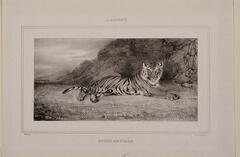
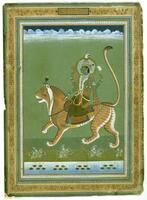
![Two distinct registers divide a page in half. At the top, a yellow-orange colored nude jina sits in lotus position upon a three tiered throne [a patterned blue level at the bottom on feet, with an orange section with gold and red decoration and a green level at the top with gold vertical stripes]. He sits against a red background adorned with a pattern of three white dots. The background takes the shape of an elegant cusped arch with a green and white pattern along its outside with a gold pattern at its sides. To the right of the seated figure a nude Digambara monk sits with his legs folded and one knee up on a less elaborate throne with a lota or pot at the corner and a crossed bookstand to the side holding a book with some devanagari writing on it. He raises his right arm and holds his left to his ear.<br />
Placed under a band of curving yellow stripes, the bottom register represents animals in a landscape. At the bottom are clumps of grass with four stylized mountain forms in blue at the right. Above the Two distinct registers divide a page in half. At the top, a yellow-orange colored nude jina sits in lotus position upon a three tiered throne [a patterned blue level at the bottom on feet, with an orange section with gold and red decoration and a green level at the top with gold vertical stripes]. He sits against a red background adorned with a pattern of three white dots. The background takes the shape of an elegant cusped arch with a green and white pattern along its outside with a gold pattern at its sides. To the right of the seated figure a nude Digambara monk sits with his legs folded and one knee up on a less elaborate throne with a lota or pot at the corner and a crossed bookstand to the side holding a book with some devanagari writing on it. He raises his right arm and holds his left to his ear.<br />
Placed under a band of curving yellow stripes, the bottom register represents animals in a landscape. At the bottom are clumps of grass with four stylized mountain forms in blue at the right. Above the](/media/W1siZiIsIjIwMjIvMDUvMjUvMXoxZ2ZnNHN6Zl9kZWZhdWx0LmpwZyJdLFsicCIsInRodW1iIiwiMjQweDIwMCJdXQ?sha=54d3764ea6247e3b)
